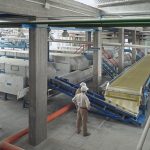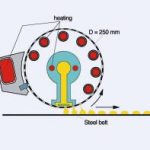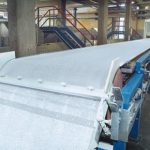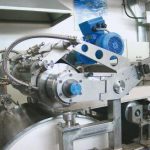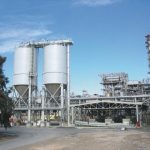The Rotoform HS (high-speed) has been specially developed for high-speed mass production of pastilles and is the latest addition to the Rotoform family from Sandvik Process Systems. The main difference compared to the standard Rotoform system is that it uses a rotating outer shell much bigger than that of the standard model. This reduces the influence of centrifugal forces on the droplets, facilitating a higher circumferential speed and thus also a higher speed of the steel belt.
The Rotoform process has proved the ideal method for pastillation of products in the chemicals, plastics and food industries for more than 20 years. The fact that melts are processed from liquid to solid in a single step is central to its success. The resulting pastilles are homogeneous, free-flowing and dust-free, and they can be produced in diameters ranging from 1 to 15 mm. The uniform pas-tille size means no screening is required, and for most applications there is also no need for subsequent crushing, milling or grinding.
The system is based on the Rotoform unit, which deposits droplets of melt onto a continuously moving steel belt that is cooled with water sprayed from behind. The excellent heat transfer of the steel belt means the droplets cool rapidly and are discharged at the end of the steel belt cooler in the form of free-flowing pastilles. The perfect synchronisation of the circumferential speed of the Rotoform’s outer shell and the moving belt gives the pastilles a consistently round shape without dust or fines.
The entire process is harmless both for the product itself and for the environment. The change from liquid to solid is performed in a few seconds (half a minute at most), and this extremely short exposure means the product has very little opportunity to pick up oxygen or other undesirable substances from the air. In the same way, little or no gas or steam can be emitted from the product, minimising or eliminating the need for air extraction. Where air extraction is unavoidable, no treatment such as scrubbing or incineration is required.
Similarly, the use of the steel belt means there is no possibility of cross contamination between the product and the cooling medium (water), and the cooling water can be recycled.
The Rotoform system has proved economical in operation and extremely flexible; capacities can be increased by installing multiple lines alongside one another and each module can be switched off and re-started at short notice, allowing easy adjustment to cope with fluctuations in production as well as for servicing and maintenance cycles.
The advantages of the system are acknowledged across many different industries and this is reflected in the fact that more than 1300 units are in operation worldwide. Ongoing development work has enabled the system to be adapted to a variety of applications and a family of nine different types is available today. They include systems specifically designed to solidify difficult products, such as those requiring feeding temperatures up to 320 °C, products with corrosive, abrasive or sub-cooling characteristics, and food products that are required to satisfy the most stringent hygiene standards. Many products which previously could not be pastillated at all can now be solidified economically and efficiently on a Rotoform system.
Rotoform HS high-speed pastillation system
Despite the enormous flexibility of the Rotoform system, changing market requirements have led to a demand for capacities exceeding those that can be satisfied by standard Rotoform solutions. A high-speed model was therefore needed to meet these requirements and the Rotoform HS is the result.
Designing this system was not simply a matter of increasing the circumferential speed of the Rotoform 3000 (the standard type in the Rotoform family). The formation of the droplet is mainly the result of gravity, so that the influence of any other forces, such as centrifugal forces, can lead to distortion of the pastilles and thus to a reduction in quality.
The most significant feature of the development was therefore the increased diameter of the rotating outer shell from 80 mm on the standard type to 250 mm on the Rotoform HS. This permitted the influence of centrifugal forces to be reduced by the same factor. The circumferential speed and rotation of the Rotoform HS – and consequently the pastillating capacity – could then be likewise increased without affecting the quality of the pastilles.
The development work profited from the experience gained with the 1300 units designed and installed to date, maintaining the proven strengths and design principles of the system but at the same time doubling its capacity. Much of the test and pilot production work was undertaken at Sandvik’s dedicated Test Centre in Fellbach, Germany.
The first prototype was tested under production conditions at a sulphur forming plant in Sicily. This particular site already makes use of ten Rotoform 3000 systems, allowing easy comparison between the traditional process and the new development. The tests proved a complete success, with the pastillation capacity of the HS system 100 % higher than that of the Rotoform 3000 installations – despite identical product quality. At the same time, several months of round-the-clock operation confirmed the mechanical functioning and reliability of all components.
Operation with the Rotoform HS
The development of the Rotoform HS means an economical process is now available for high-speed pastillation. Further pilot tests showed that the system is also ideal for pastillating low-viscosity melts and that high-speed pastillation can be achieved with a number of different prod-ucts, including:
- Sulphur 12.0 t/h
- Urea 5.0 t/h
- Bisphenol A 2.7 t/h
- Maleic anhydride 2.5 t/h
- Naphthalene 3.5 t/h
These figures are ‘starting’ capacities; all previous experience shows that capacities can be increased further still through process optimisation and building on the know-how accumulated in actual production.
While the basic principle of the Rotoform was not changed in the development of the HS model, the opportunity was taken to improve certain components and integrate new functionality made possible by the increased diameter of the rotating shell.
One of the most important innovations was to increase the system’s user-friendliness for servicing. The number of necessary spare parts was reduced, the use of rotating seals eliminated and the main bearings made more easily accessible by means of a swing-out unit. A pneumatic lifting facility can lift the unit into the service position to give better access for maintenance of all parts. This facility also improves safety – if anything is accidentally caught between the dropformer and the belt, the dropfor-mer is automatically raised to minimise the risk of damage or injury.
A complete Rotoform HS pilot plant is installed at the company’s European Test Centre in Germany, and tests with clients’ own products can be performed at relatively short notice. In cases where the pilot plant might not be suitable, such as when larger quantities of product need to be handled or for safety and security reasons, a ‘mobile’ system can be delivered anywhere in the world for tests on the client’s site. Regardless of whether the tests are performed in the Test Centre or locally, experienced Sandvik engineers are always available to provide advice and assistance.
Hall 4.0, Booth F2
cpp 402
Sandvik Rotoform process
Achema 2006
Share:



